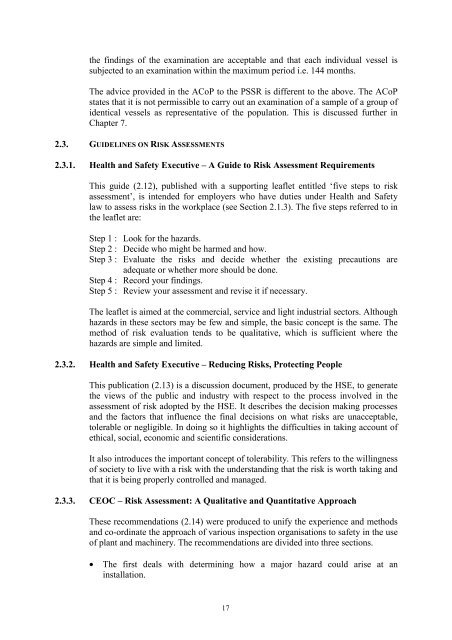Best Practice for Risk Based Inspection
risk based inspection
risk based inspection
You also want an ePaper? Increase the reach of your titles
YUMPU automatically turns print PDFs into web optimized ePapers that Google loves.
the findings of the examination are acceptable and that each individual vessel is<br />
subjected to an examination within the maximum period i.e. 144 months.<br />
The advice provided in the ACoP to the PSSR is different to the above. The ACoP<br />
states that it is not permissible to carry out an examination of a sample of a group of<br />
identical vessels as representative of the population. This is discussed further in<br />
Chapter 7.<br />
2.3. GUIDELINES ON RISK ASSESSMENTS<br />
2.3.1. Health and Safety Executive – A Guide to <strong>Risk</strong> Assessment Requirements<br />
This guide (2.12), published with a supporting leaflet entitled ‘five steps to risk<br />
assessment’, is intended <strong>for</strong> employers who have duties under Health and Safety<br />
law to assess risks in the workplace (see Section 2.1.3). The five steps referred to in<br />
the leaflet are:<br />
Step 1 : Look <strong>for</strong> the hazards.<br />
Step 2 : Decide who might be harmed and how.<br />
Step 3 : Evaluate the risks and decide whether the existing precautions are<br />
adequate or whether more should be done.<br />
Step 4 : Record your findings.<br />
Step 5 : Review your assessment and revise it if necessary.<br />
The leaflet is aimed at the commercial, service and light industrial sectors. Although<br />
hazards in these sectors may be few and simple, the basic concept is the same. The<br />
method of risk evaluation tends to be qualitative, which is sufficient where the<br />
hazards are simple and limited.<br />
2.3.2. Health and Safety Executive – Reducing <strong>Risk</strong>s, Protecting People<br />
This publication (2.13) is a discussion document, produced by the HSE, to generate<br />
the views of the public and industry with respect to the process involved in the<br />
assessment of risk adopted by the HSE. It describes the decision making processes<br />
and the factors that influence the final decisions on what risks are unacceptable,<br />
tolerable or negligible. In doing so it highlights the difficulties in taking account of<br />
ethical, social, economic and scientific considerations.<br />
It also introduces the important concept of tolerability. This refers to the willingness<br />
of society to live with a risk with the understanding that the risk is worth taking and<br />
that it is being properly controlled and managed.<br />
2.3.3. CEOC – <strong>Risk</strong> Assessment: A Qualitative and Quantitative Approach<br />
These recommendations (2.14) were produced to unify the experience and methods<br />
and co-ordinate the approach of various inspection organisations to safety in the use<br />
of plant and machinery. The recommendations are divided into three sections.<br />
• The first deals with determining how a major hazard could arise at an<br />
installation.<br />
17



